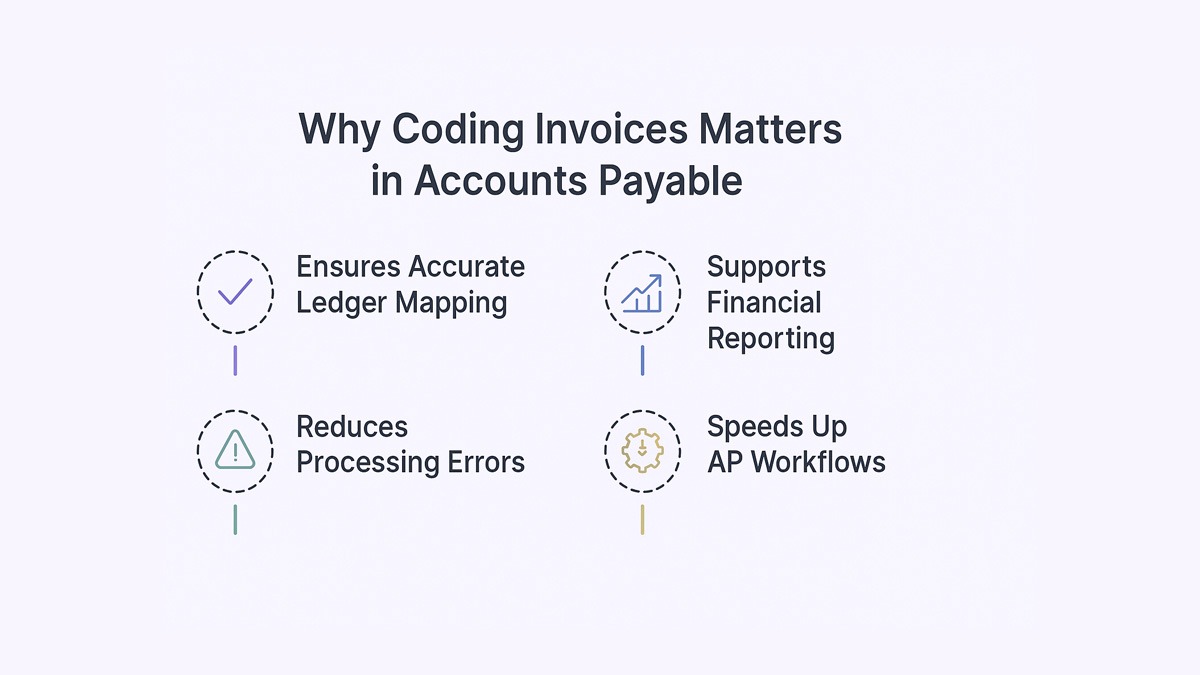

Invoice Coding: Definition, Process & How Automation Streamlines It

Invoice Coding: Definition, Process & How Automation Streamlines It
Learn what invoice coding is, how automation streamlines it, and why it’s key to efficient accounts payable and accurate financial reporting.


Ever tried finding a single receipt in a stack of hundreds, all without any labels or structure? That’s what managing invoices without proper coding feels like - confusing, time-consuming, and error-prone. For finance and AP teams, invoice coding is the backbone of a streamlined, accurate payment process. It ensures every dollar is tracked, every charge is validated, and reporting makes sense at scale.
What this blog covers:
- What is invoice coding?
- Why coding invoices matters in accounts payable
- How to write an invoice code
- The challenges of manual invoice coding
- What is automated invoice processing?
- How automation streamlines invoice coding
- How Spendflo helps with invoice coding automation
- Frequently asked questions on coding invoices
What is Invoice Coding?
Invoice coding is the process of assigning general ledger (GL) codes to invoice line items to ensure accurate expense categorization and accounting. It enables businesses to track spending by department, cost center, or project, helping finance teams maintain accurate financial records and stay audit-ready.
Why Coding Invoices Matters In Accounts Payable
Without proper invoice coding, accounts payable becomes a guessing game - one where mistakes can snowball into compliance issues, budget overruns, or missed payments. Here’s why coding invoices isn’t just a “nice-to-have” but a non-negotiable for any finance team that values control and clarity.

Ensures Accurate Ledger Mapping
Every invoice needs to land in the right spot in your general ledger. Coding assigns specific GL codes to each line item, ensuring expenses are accurately tracked under the right categories - whether it’s marketing spend, software licenses, or employee travel. This makes month-end reconciliation smoother and more reliable.
Reduces Processing Errors
Manual data entry is risky business. Coding minimizes human error by introducing structure. When each invoice follows a standardized code format, it’s easier to flag discrepancies, avoid duplicate payments, and catch anomalies before they escalate.
Supports Financial Reporting
Accurate coding feeds clean data into financial reports. It enables granular analysis by department, vendor, or cost type. That level of visibility helps finance leaders make better, faster decisions and forecast spend with more confidence. Clean coding also feeds directly into accurate financial statements for leadership reviews.
Speeds Up AP Workflows
Time is money - and manually decoding invoices eats up both. With predefined coding schemes, AP teams can process invoices faster, freeing up time to focus on exceptions, vendor communication, or strategic tasks.
How to Write an Invoice Code
Writing an invoice code may sound like a minor task, but it's actually one of the most important steps in organizing your financial data. A well-structured invoice code helps your AP team track expenses quickly, categorize payments accurately, and reduce confusion across departments. Here’s what goes into it - and how to get it right.
Key Components of an Invoice Code
Most invoice codes include a combination of identifiers that reflect different dimensions of the expense. This can include the department (e.g., HR, IT), (e.g., HR, IT), cost center, account number, and sometimes a project or location tag. For example: IT-501-1234-NYC could represent an IT software subscription under account 501, linked to project 1234 in the New York office.
Common Invoice Coding Formats
Some companies use alphanumeric codes; others prefer numerical strings. The key is consistency. Codes should follow a repeatable format so that anyone in finance can read them at a glance. Many ERP and AP systems allow you to customize these templates, making standardization easier.
Examples of Invoice Coding in Action
Let’s say your marketing team purchases ad space. The invoice might be coded as MKT-602-ADSPEND-Q4. That code instantly tells reviewers the team, account type, and quarter, speeding up reviews and approvals. It also helps ensure that purchases comply with applicable tax rules.
Tips to Standardize Your Invoice Coding
Create a centralized coding chart or GL guide for your team. Train new hires on the coding structure. Ongoing employee training ensures coding accuracy as processes evolve. And always review new vendors or invoice types to make sure they're mapped correctly from day one.
The Challenges Of Manual Invoice Coding
Manual invoice coding might seem manageable when you’re dealing with a handful of invoices. But as volumes increase, so do the cracks. Errors creep in. Time drags on. And before you know it, your finance team is buried in paperwork, chasing down codes instead of driving value. Here’s a closer look at why manual coding simply doesn’t scale - and what it’s costing you.

Time-Consuming Processes
At its core, manual invoice coding is slow. Every line item has to be reviewed, understood, and tagged with the correct general ledger code. Multiply that by hundreds - or thousands - of invoices a month, and the hours stack up fast. What’s worse, those hours often come at the cost of more strategic finance work.
Inconsistent Coding Practices
Not everyone codes the same way. Different team members might interpret an expense differently or use outdated codes. Without a clear, enforced structure, it’s easy to end up with mismatched entries that skew financial reports and slow down audits. Inconsistent codes also create confusion for leadership teams trying to understand spend categories.
Human Errors and Misclassification
Fat-finger mistakes happen. Misclassifying a charge can even affect the wrong customer account in some systems. A simple typo in a GL code can send an invoice to the wrong expense category, impacting budget accuracy and monthly reports. More critically, if you’re dealing with multiple currencies, vendors, or subsidiaries, even a small misclassification can trigger cascading issues across systems.
Compliance and Audit Risks
Manual processes often lack a paper trail. If codes are applied without approvals or documentation, it becomes difficult to prove compliance during an audit. Consistent coding practices also support error-free tax reporting across jurisdictions. Regulators and auditors look for transparency and traceability - both of which are harder to demonstrate with handwritten notes or spreadsheet-based systems. Missing documentation or misfiled invoices can also open your business to penalties or lost credibility.
Manual coding isn’t just inefficient - it’s risky. And the bigger your business gets, the bigger those risks become.
What is Automated Invoice Processing?
Automated invoice processing is the use of software to capture, validate, and route invoices - without relying on manual entry. Instead of chasing down spreadsheets or deciphering handwritten codes, finance teams can lean on technology to do the heavy lifting. The result? Faster processing, fewer errors, and greater control over spend.
Invoice Data Extraction
Automation tools use OCR (optical character recognition) or AI to scan invoices - whether PDF, paper, or digital - and extract key data like invoice number, vendor name, date, and total amount. No need for retyping.
Auto-GL Coding and Matching
Smart systems can automatically assign general ledger codes based on vendor rules, expense type, or past behavior. These tools also capture the invoice date automatically for accurate tracking. They also match invoices against purchase orders and receipts, flagging mismatches for review. Advanced tools use invoice matching to catch duplicate or incomplete entries.
Approval Workflows and Notifications
Once coded, invoices are routed to the right stakeholders for approval, often within the same platform. Built-in notifications prevent delays and keep things moving.
Audit-Ready Recordkeeping
Every step of the process is logged and stored - so you have a clean audit trail without extra admin work.
How Automation Streamlines Invoice Coding
Invoice coding doesn’t have to be a bottleneck. With automation, it becomes a seamless, almost invisible part of the accounts payable flow. Instead of manually tagging every line item, intelligent systems apply pre-set GL codes based on vendor history, expense type, or keyword detection. This drastically cuts down on manual input, speeds up processing time, and reduces human errors. Integrating an accounting system can further streamline data flow and reconciliation. Plus, with built-in validations and exception handling, only anomalies get flagged for review - freeing your team to focus on high-value tasks. In short, automation transforms invoice coding from a reactive task into a proactive control mechanism.
How Spendflo Helps with Invoice Coding Automation
Spendflo simplifies and accelerates invoice coding by integrating smart automation directly into your SaaS procurement and spend management workflow. Our platform automatically assigns GL codes based on vendor profiles, contract terms, and historical data - removing the guesswork from AP. With real-time tracking, approval workflows, and centralized visibility, your finance team can ensure accuracy without lifting a finger. These tools also unlock deeper finance insights for strategic planning. It’s invoice coding made effortless, so you can focus on strategic decisions - not data entry.
Frequently Asked Questions on Coding Invoices
What is invoice coding in accounts payable?
Invoice coding is the process of tagging each invoice line item with the correct general ledger (GL) code to reflect the nature of the expense. This ensures accurate bookkeeping, reporting, and budgeting.
How does automated invoice coding work?
Automated invoice coding uses software to extract invoice data and apply the appropriate GL codes based on predefined rules, vendor history, or AI-driven suggestions. It reduces manual effort and speeds up approvals.
What are common mistakes in manual invoice coding?
Errors often include misclassifying expenses, using outdated or incorrect GL codes, skipping approvals, and entering inconsistent data - all of which can disrupt reporting and audits.
Can automation reduce AP processing time?
Yes, automation dramatically reduces AP processing time by eliminating repetitive tasks like data entry, manual validations, and approval routing. Invoices move faster and with fewer errors. Standardized coding also helps keep payment cycles consistent and predictable.
How do automation workflows and invoice management systems improve AP efficiency?
Automation workflows in modern invoice management systems help process large invoice volumes with speed and accuracy. These systems minimize human effort while ensuring compliance and reducing delays.
What role do machine learning and artificial intelligence play in handling invoice volumes?
Machine learning and artificial intelligence enhance invoice processing by learning from patterns and predicting errors. As invoice volumes grow, these technologies support scalability and real-time decision-making.










.png)




.png)










.avif)


